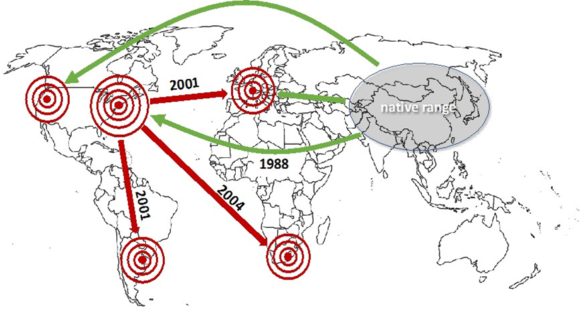Ectothermic organisms rely on their surrounding conditions to maintain temperatures within a range that optimizes essential activities such as running, foraging and reproducing. Beyond this range, their performance or fitness decreases with a particularly fast loss of performance at high temperatures. Therefore, the temperature limits (also known as critical thermal limits) that encapsulate animal performance are expected to be good predictors of cold and warm boundaries delimiting the geographic distributions of species. Significant relationships between species performance limits and distributions can improve predictions on species distribution shifts resulting from climate change. They can also indicate where population extirpations are most likely to occur. However, many other factors can limit species distributions, including interactions with other species, inability to disperse and nutritional requirements. Overall, we still have a poor understanding of the causes of variation of upper and lower temperature limits among species today.
In this project1, a group of 17 scientists, including Associate Professor Susana Clusella-Trullas from the Centre for Invasion Biology, Dept. of Botany and Zoology, Stellenbosch University, explored how species’ thermal limits have evolved across the tree of life. After careful curation of data collected from the literature, they were able to gather temperature limits for more than 2000 species, including aquatic and terrestrial animal and plant species. The goal was to use these data to test several hypotheses relating to processes that have shaped the variation of critical temperature limits of organisms on Earth.
The first hypothesis we tested was that the climate experienced by the ancestors of species we see today may have had limited opportunities to evolve from those original conditions. This hypothesis rests on the assumption that species niches, which encapsulate their functional requirements, stay constant through time. The second hypothesis we tested states that there are constraints that limit further evolution of temperature limits beyond a particular value. For example, high temperatures negatively affect the integrity of membranes and proteins in animals, jeopardizing performance above particular thresholds. We therefore expected that the evolution of upper temperature limits would follow a model of selection that stabilizes towards a particular value as opposed to a random change of the trait through time. Lastly, our third hypothesis was that current temperature regimes and extremes shape the temperature limits of organisms. This trend should be more pervasive in the cold limits of tolerance because organisms typically have no refuges from cold while in warm conditions most habitats have some heterogeneity with options to escape heat stress.

Using a unique large compilation of temperature limits of plants and animals, we found support for several of the hypotheses proposed but the mechanisms depended on the trait examined. For example, we found that cold and warm climatic periods of the past shaped part of the cold tolerance variation we currently find among organisms. In other words, deep-time climate legacies have left an imprint on cold tolerance (hypothesis 1). By contrast, this is not the case for warm tolerance. The variation in the ability to withstand high temperature has evolved in a non-random way, following a particular direction towards a peak or hard boundary (hypothesis 2). These results suggest that further adaptation of high temperature tolerance to warming temperatures is likely to be constrained. When facing heat extremes, most organisms could face local extinctions if other rescue mechanisms are not in place. Finally, both cold and warm tolerance limits of organisms are also associated to current climates. In addition to the mechanisms stated above (hypothesis 1 and 2), the variation in both cold and warm temperature tolerance among organisms also reflects their contemporary temperature regimes experienced in the field, and in particular extreme events (hypothesis 3).
While working with empirically measured traits of more than 2000 species seems impressive, this number is infinitesimal relative to the number of current extant species, and therefore we are just scratching the surface. Adding to this empirical dataset and doing so for a much larger diversity of species and habitats2 will be key to further explore the sources of variation of tolerance limits and assess the capacity of species to adapt to, or be threatened by, climate change.
Read the paper
Additional reading
For more information, contact Susana Clusella-Trullas at sct333@sun.ac.za



